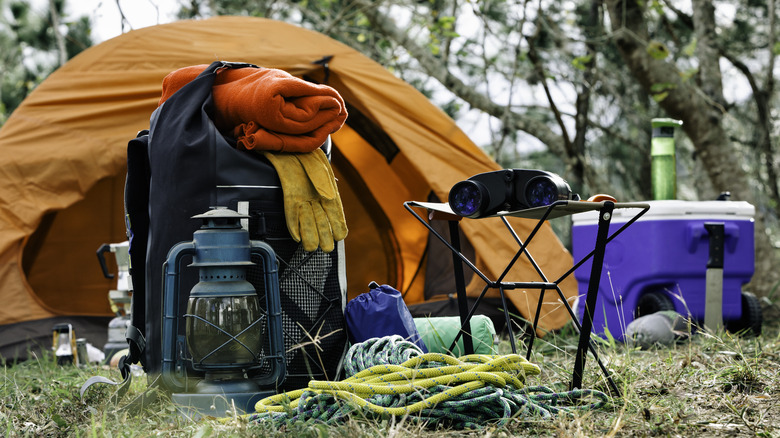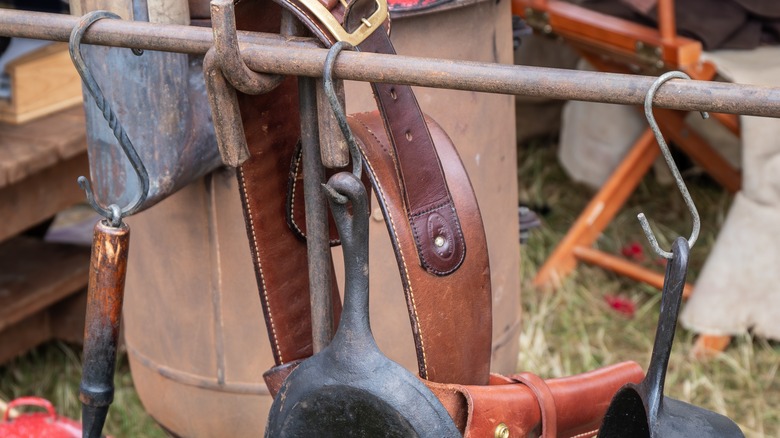Keep Your Campsite Tidy By Adding These Essentials To Your Camp Packing List
When you are camping, you are essentially living outdoors for a period of time. If you look at camping from that perspective, your campsite is basically your homesite while you are on a camping expedition. Just as it makes life easier if your home is nice and tidy, camping and the accompanying outdoor activities will be that much more enjoyable if your campsite is tidy, orderly, and organized as well. This is true whether you are camping alone or with a large group. With that in mind, you can help keep your campsite tidy by adding these essentials to your camp packing list (if you don't have a camp packing list, that's something else you need to add as it is the best way to avoid forgetting essential gear).
The items on this list are not essential camp goods, gear, supplies, or emergency camping supplies, but not including them is definitely a mistake to avoid when packing for a camping trip. While some of these items are meant to help transport goods in an orderly manner as well as aid in keeping your campsite tidy, others are packable, so they don't take up much space and can be utilized as needed on a camping trip.
Clear storage tubs let you see your gear
Organizing your campsite actually begins before you even leave your home. How you pack for a camping trip and what you use to store your camping gear can translate to a tidy campsite. Clear plastic storage tubs are ideal for this purpose. For starters, clear tubs allow you to see what is in each one at a glance. This will save valuable time that may otherwise be spent digging through tub after tub. Utilizing stackable tubs will make transporting gear more efficient and also help reduce clutter at the campsite. They also are invaluable for keeping gear dry while camping.
When the tubs are emptied of contents that don't need to be stored during the trip — items such as sleeping bags, tents, etc. -– the tubs can be nested or stacked inside one another, which will further reduce clutter and your campsite footprint. Additionally, these empty tubs can be utilized as wash tubs and camp sinks while not being used to store gear. This eliminates the need to bring extra equipment for those purposes.
Zipper bags store food and other items
Clear zipper bags, such as Ziplocs, are invaluable for keeping a campsite tidy. They come in a wide range of sizes, but pint, quart, and gallon are perhaps the most versatile when it comes to camping applications. Most campers already utilize these clear, sealable bags to store food. However, bringing a stash of extra bags can come in handy. For starters, they can be used to hold leftover food, freshly cut fruits and veggies — things that weren't necessarily held in zipper bags on the way to the campsite.
However, in addition to food, zipper bags can also be used to hold various small items. Personal items like wallets and jewelry can be tucked into a zipper bag at the end of the day so they can be easily located the next morning. Any odds and ends collected during a trip or any items you want to keep dry, yet easily accessible outside the storage totes can also be dropped into zipper bags.
As an added bonus, zipper bags do not take up much space, so it is easy to take a stash of them along to use as needed during your camping trip. Additionally, there are eco-friendly, reusable versions of this handy zipper sacks available as well.
Hanging organizers keep gear off the ground
Multi-pocketed hanging organizers, such as those designed to hold shoes, are great for keeping a variety of items off the ground and easily found. For starters, hanging shoe organizers can be used to hold shoes. This is no small advantage at a campsite, where multiple pairs of shoes and boots can quickly become a cluttered mess. Hanging shoes and boots not only keeps them orderly and easily found, it also helps prevent critters such as scorpions from crawling inside overnight.
Additionally, hanging organizers are a convenient spot to put other things, including zipper bags full of valuables and other miscellaneous items. Cooking and eating utensils, gloves, caps, earbuds, socks, toiletries, flashlights, and phones are just a few other examples of things which can be stored in the compartments of hanging organizers. Depending on the type of items stored in the organizer, it can be hung inside your tent, under a canopy, or on a tree branch.
Mesh bags offer open-air organization and storage
Campers often think about having dry bags of all sizes to store gear, take on hikes, and keep their possessions out of the elements. However, not everything on a camping trip needs to be kept sealed. In fact, some things need to be aired out. This is where mesh bags come in clutch. By design, the holes in a mesh bag let air in and small dirt and debris out. Both of those characteristics can come in handy for various camping applications.
Regardless of what activities you plan to take part in during a camping trip, you will end up with dirty clothes. Keeping these worn clothes in a mesh bag will allow them to air dry and help prevent the growth of mold and bacteria during the remaining time of your camping trip. Mesh bags are also handy for allowing gear used in wet activities such as snorkeling to air dry. Even pots, pans, and dishes can be placed in a mesh bag after washing to be allowed to dry.
No matter what you are placing in a mesh bag, suspending it off the ground by hanging it on a stake, limb, or other elevated object can aid in the drying process and allow any water or dirt to fall through the bag.
Hanging gear on S hooks helps with organization
Hanging items, large or small, is a great way to organize a campsite, keep it tidy, and prevent animals from rummaging through your goods. As a result, whenever and wherever you are camping, there never seems to be a shortage of items which need to be hung. Whether it be food, clothes, gear, lighting, or anything else that needs to be suspended, having a ready supply of S hooks can make that task much easier. Because they are open on each end, S hooks are not as limited as other hanging devices. To put an S hook up, simply find a post, pole, branch, limb, or board it fits over. Then, dangle whatever items you wish to hang on the other end.
Some of the items already mentioned in this list -– mesh bags and hanging organizers, for instance -– are good candidates for being hung from S hooks. Backpacks, caps, cooking utensils, pots and pans, and many other pieces of camping gear are also easy to hang from S hooks for organization and convenience. S hooks can also be used to hang lights, whether it be lanterns, flashlights, or string lights, to help illuminate your campsite.





